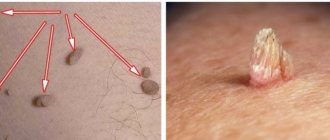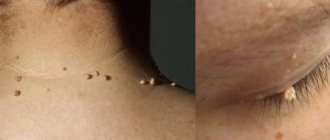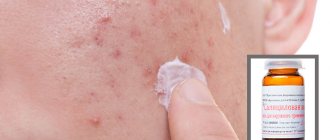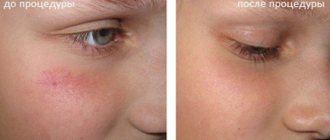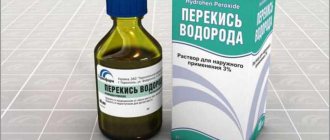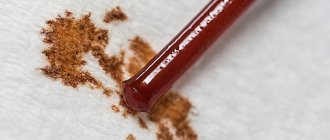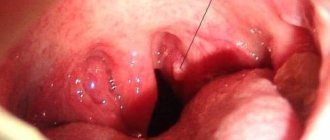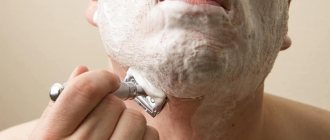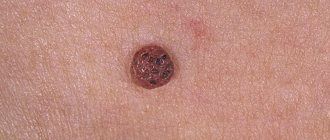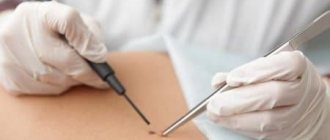Electrocoagulation is one of the electrosurgery methods that is used to remove various tumors that have appeared on the skin. In recent years, dermatologists and cosmetologists are increasingly turning to specialists for help with the appearance of various neoplasms (nevi, papillomas, warts, fibroids, red moles, etc.). It is possible that neoplasms may be present on the skin from birth or appear throughout life. Their removal today is often carried out using electrocoagulation.
Removal of benign skin tumors using electrocoagulation
Let's understand the terminology.
Various electrical devices for burning and cauterizing tumors have existed for quite a long time. Therefore, the term “electrocoagulation” is used very widely and in different meanings.
So, there are two fundamentally different methods of “electric burning”:
- Thermocoagulation (cauterization, thermocauterization, electrothermocautery).
- Diathermocoagulation (electrocoagulation, high frequency electrosurgery - EHF, HF coagulation, radiosurgical method, radio wave surgery, radio knife, radio scalpel,).
The method is based on the action of a metal electrode heated to a high temperature, similar to a soldering iron or wood burner. In this case, the tissues are actually burned out with a “hot iron”.
Since heating of the metal occurs under the influence of electric current, the procedure is often also called “electrocoagulation”.
The method is based on the influence of high-frequency electromagnetic oscillations (current). Due to the transfer of energy through the electrode to the tissues, coagulation (“cauterization”) or cutting occurs.
Unlike thermocoagulation, the electrode itself practically does not heat up.
The difference between an EHF (electrosurgical high-frequency) device and a radioknife (the most common model is the Surgitron device) is that the EHF uses a high-frequency current - about 400 kHz, and the radioknife - up to 4 MHz.
Pros and cons of electrocoagulation
Content:
- What are the methods for removing warts?
- Pros and cons of electrocoagulation
- In what cases is electrocoagulation contraindicated?
- How is electrocoagulation performed?
- Rehabilitation after electrocoagulation
Each technique has its advantages, but electrocoagulation has the most positive aspects. Firstly, the procedure is quite quick compared to others, and at the same time it is absolutely painless. During the removal of skin formations, there is completely no risk of bleeding, and this, in turn, prevents infection of wounds and the onset of the inflammatory process.
Electrocoagulation is considered one of the safest removal methods, since only warts are burned off by electric current, and the skin around them is not affected. After such procedures, the patient recovers quickly, and the rehabilitation period passes faster. In isolated cases, a relapse may occur. Also, an equally significant advantage is the price of the procedure, because compared to others, it costs several times less.
As medical practice shows, some time after removing a wart using electrocoagulation, as a rule, there are no repeated growths in this place.
If we consider the negative aspects of this technique, we can highlight only one disadvantage. Sometimes patients experience itching and burning at the site of the burn. As experts explain, this is the result of individual intolerance to local anesthetics.
What is the advantage of diathermocoagulation?
- There is no deep necrosis or trauma.
- The healing process accelerates (starts from 2–3 days).
- Healing without the formation of a rough postoperative scar, high cosmetic effect.
- Minimal pain and swelling in the postoperative period.
- Sterilizing effect of high frequency waves: there is practically no infection.
- A “dry” (bloodless) incision makes it easier for the surgeon to view the surgical field.
- The ability to obtain high-quality, most accurate histological tissue samples.
- All operations are performed on an outpatient basis (after the intervention the patient goes home).
Prevention of scar formation, age spots and recurrence of papillomas.
After the crusts fall off, delicate pink skin appears at the site of the wound, which must be protected from injury and exposure to sunlight - this can cause burns and age spots. Therefore, after the natural rejection of the crusts, the skin must be carefully lubricated with sunscreens with a high degree of protection or sealed with a bactericidal patch for the duration of exposure to the sun (this does not depend on the time of year). To prevent the formation of pigment spots at the site of the removed papilloma, it is necessary to avoid visiting a solarium and/or exposure to ultraviolet rays. Until the young epithelium at the site of papilloma removal gets stronger and acquires the color of the surrounding tissues, you should not use decorative cosmetics and foundation (even if the operated area is on the face). Also, you should not treat your skin with scrubs, alcohol lotions, irritating ointments, or expose your skin to various chemically active substances containing acids, chlorine or alkalis. Various hygiene procedures should be carried out with caution: do not rub with a pumice stone or washcloth, avoid visiting saunas and baths for two months after the procedure. After removal of papillomas during the recovery period, to increase the regenerative ability of the skin, its elasticity and resistance to external negative influences, patients are recommended to take vitamins A and E (“Aevit” 1 capsule once a day, oil solutions of tocopherol acetate (10 mg), vitamin A ( 2300 IU daily) or multivitamin-mineral complexes). To prevent secondary infection and recurrence of papillomas, experts recommend taking measures and taking medications aimed at strengthening and increasing immunity - healthy sleep, hardening, ascorbic acid, herbal adaptogens (tinctures of echinocea, ginseng, eleutherococcus).
Does it hurt or not?
The manipulation is anesthetized locally. General anesthesia is not required.
Pain relief can be:
- Injection (in the form of an injection).
- Application (application of a local anesthetic in the form of a cream or patch).
The first option is a little uncomfortable (at the moment of injection), but it works almost instantly, and you can immediately begin the manipulation.
The second option does not cause discomfort, but it takes time (about 1 hour if we are talking about skin) for the medicine to penetrate deep into the tissues. If manipulation of the mucous membranes is intended, then the cream also acts immediately.
Indications and contraindications for the procedure
There are also contraindications for this procedure, including:
- presence of herpes in active form;
- bleeding disorders or the presence of other blood diseases;
- acute form of somatic diseases or chronic during exacerbation;
- intolerance to electrical procedures and anesthetics;
- the presence of malignant neoplasms.
Electrocoagulation is actively used in cosmetology and medicine. Using this procedure, you can treat certain diseases, as well as eliminate defects on the skin. There are no strict medical indications for the removal of benign skin lesions. But it is still believed that papillomas, moles and warts must be removed in order to protect yourself and your body from possible complications. The doctor can prescribe an appointment for the procedure in the presence of the following pathological conditions or diseases:
- the presence of polyps in the labia area;
- cervical erosion;
- cystic acne;
- seborrheic keratosis;
- nevus, regardless of its location;
- Darier's disease;
- skin hyperpigmentation;
- warts, regardless of their type;
- condylomas and skin papillomas.
All of the above conditions, as well as xanthelasma, molluscum contagiosum, wen, and spider veins on the skin can be removed without much effort and further complications by using the electrocoagulation procedure.
Are there any restrictions after the procedure?
A crust forms at the site of the incision or coagulation. It is recommended to treat it with a 5% solution of potassium permanganate (potassium permanganate) 2 times a day.
The crust will come off on its own within 2 to 4 weeks. It is advisable not to tear off the crust: this prolongs the healing process and can cause infection or scarring.
You can take a shower after the procedure on the same day, but without intensely rubbing the area of manipulation with a washcloth (so as not to damage the crust). It is not advisable to take a bath for several days, again for reasons of preserving the crust.
For a month after the procedure, you should not expose the manipulation site to sunlight, as persistent, unsightly hyperpigmentation may form.
After the wound has healed, photoprotective agents with SPF 50 should be used for another 6 months, since young skin is more sensitive to ultraviolet radiation.
How is electrocoagulation performed?
Compared to other procedures, electrocoagulation is simple to perform. According to statistics, just one procedure is enough for complete removal. You can also remove several large warts at the same time. It is the size of the wart that determines the speed of the procedure. This may take a minute or even a few seconds.
Before removing a wart, the patient is given local anesthesia, and the skin is pre-treated with antiseptics.
Direct removal is carried out using a loop located on the device. It is applied to the wart and a certain electric current is applied. Thus, the wart tissue is thermally damaged and dies. If the wart dies, why doesn't it start bleeding? The high temperature of the loop also cauterizes the blood vessels that fed the wart. Therefore, bleeding does not start, and this avoids infection.
The site of the wart is covered with a dense crust (scab). After several days, the process of complete tissue healing proceeds smoothly. Once they heal, the crust will fall off on its own.
Before the procedure itself, all jewelry made of metal is removed from the patient. Otherwise, heating may cause burns.
Many patients, especially women, are interested in the question of scars. The wound itself heals in an average of ten days after the wart is removed. After the crust falls off, a pink spot remains on the skin (as doctors say, this is young skin). If doctors removed a small formation with a shallow core, then over time it will blend in with the color of the skin.
If during the development of a wart a deep layer of skin was affected, then a light spot remains in place, but don’t worry, it will go away over time.
Best materials of the month
- Coronaviruses: COVID-19
- Antibiotics for the prevention and treatment of COVID-19: how effective are they?
- The most common "office" diseases
- Does vodka kill coronavirus?
- How to stay alive on our roads?
Indications
Removal of papillomas with electric current is carried out under the following circumstances:
- increase in the size of the tumor;
- change in color of papilloma;
- the emergence of a large number of new neoplasias;
- location of the growth in an area where there is a high risk of damage;
- the appearance of pain in the affected area.
Any of these features requires contacting a specialist. They indicate the likelihood of cells degenerating into a cancerous tumor.
But even without the listed symptoms, this procedure can be prescribed. This is done when papillomas are found on visible areas of the body, which negatively affects a person’s appearance.
Are there any consequences or complications?
If the manipulation is performed correctly, no complications arise. They are possible due to technology violations, the presence of contraindications or improper care after electrocoagulation.
In these cases, bleeding and allergic reactions may occur. Allergies are provoked by medications used during electrocoagulation or after it - to treat the wound surface. Because of this, the regeneration period may be delayed.
Bleeding occurs when large vessels are damaged during the procedure. Therefore, it is very important that papilloma removal is carried out by an experienced specialist.
On this topic
- Skin covering
What does a wen look like on the body?
- Olga Vladimirovna Khazova
- December 5, 2021
If an infection has been introduced into the wound, an inflammatory process may begin with the formation of pus. The same consequences can occur if the crust is forcibly removed. It is also possible for pigment spots or scars to form.
Failure to comply with precautions may cause re-formation of papilloma or the appearance of atypical cells in this area. Under favorable circumstances, they can degenerate into a malignant tumor.
This occurs due to injury, infection, sun and chemical burns and under the influence of harmful substances. Therefore, it is necessary to protect the skin from dangerous influences.
Patient reviews
Tatyana is 24 years old.
I went to the doctor to have a papilloma removed on the back of my neck. She constantly got in my way and couldn't wear chains or necklaces. Electrocoagulation was recommended. After examination, they gave an injection and removed it in a few minutes. It didn't hurt. I had to not wet the wound for several days and treat it with alcohol, but on the 10th day the crust fell off on its own. A small light scar remained, which almost disappeared within 4 months. I regret that I didn't do this earlier.
Sergey 42 years old.
I had a papilloma removed from my armpit. She often bothered me. In the summer it’s hot, I sweat, and this pendant turns red and hurts. I had to go to the doctor. Removed it in 5 minutes. The doctor advised me to take sick leave, since I am a truck driver and often leave. I was lying at home, and my wife was smearing it with brilliant green. Everything went away within 2 weeks. It's a shame that I suffered with her for so long.
Alina is 33 years old.
I was removing a wart on my hand and accidentally tore off the scab. Although the doctor warned not to touch it. Underneath the wound is red around the edges and white in the middle. I went to the doctor. She processed it. It healed well, but there was a scar. It's small, but still unpleasant.
Causes of papillomas
You can become infected with the human papillomavirus through direct contact or failure to comply with personal hygiene rules. But it does not cause papillomatosis in every person. The main reasons for its development:
- Decreased general and local immunity of the body.
- Hormonal imbalance.
- Diseases causing metabolic disorders.
- Pregnancy.
- Stress.
Against this background, HPV is activated and causes the formation of papillomas, warts on the skin and mucous membranes.
How does the procedure work?
Removing the tumor takes about 30 minutes and does not require special preparation. The procedure is performed under local anesthesia; the doctor injects an anesthetic into the surgical area, having previously treated the skin with an antiseptic solution. The formation is cut off with a thin electric knife in one movement, and the patient does not feel pain.
After the procedure, the skin needs recovery. The SlimClinic doctor will tell you in detail about wound care and the limitations of the recovery period. After 7-10 days, you need to visit the cosmetologist again for a follow-up examination.
Skin neoplasms
Under the influence of various factors, ranging from infections and tight clothing to genetics, convex formations may appear on the smooth surface of the skin, for example, moles, warts, papillomas, condylomas, fibroids, calluses.
Most often, they are small, painless and do not interfere with a person’s normal life and going about their business. But in some cases, these small troubles can turn into a big problem.
- Large skin defects on the face, hands, and genitals cause aesthetic discomfort.
- Growths in the armpits, hands and feet, crooks of the limbs, groin and other areas with high levels of sweating interfere with movement, can cause discomfort and can be damaged and infected during physical activity or sports.
- Skin tumors that have a thin interception - papillomas - are especially dangerous. Small vessels and nerves often pass through this narrow leg, so twisting or pinching it is painful and can lead to necrotic processes.
- Small moles that suddenly begin to grow and visually change indicate malignant processes in the body.
Skin defects that cause discomfort cannot be removed on your own. Incorrectly performed manipulations lead to the introduction of infection into the blood, and in some cases provoke the degeneration of a benign neoplasm.
general information
Electrocoagulation is a procedure aimed at cauterizing soft tissues and removing various growths. This method involves the use of electric current acting on the affected area with the required strength and frequency.
Today there are two types of use of electric knife , selected by the doctor depending on the purpose of the intervention:
- contact surgery (this includes electrocoagulation, electrocautrization, etc.);
- non-contact surgery (electrofulguration and plasma coagulation).
The latter type of procedure is characterized by the presence of a device that supplies a beam of energy that destroys the tumor. With the contact method, the device comes into direct contact with the affected area on the patient’s body. This type of operation is chosen to remove papillomas and condylomas.
